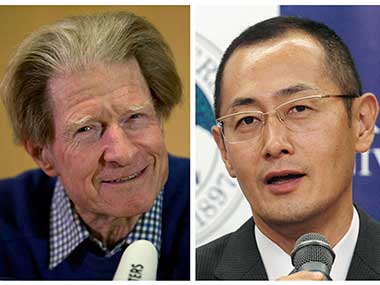New York: Two scientists from different generations won the Nobel Prize in medicine Monday for the groundbreaking discovery that cells in the body can be reprogrammed into completely different kinds, work that reflects the mechanism behind cloning and offers an alternative to using embryonic stem cells. The work of British researcher John Gurdon and Japanese scientist Shinya Yamanaka — who was born the year Gurdon made his discovery — holds hope for treating diseases like Parkinson’s and diabetes by growing customised tissue for transplant. And it has spurred a new generation of laboratory studies into other illnesses, including schizophrenia, which may lead to new treatments. Basically, Gurdon, 79, and Yamanaka, 50, showed how to make the equivalent of embryonic stem cells without the ethical questions those very versatile cells pose, a promise scientists are now scrambling to fulfill. Once created, these “blank slate” cells can be nudged toward developing into other cell types. Skin cells can ultimately be transformed into brain cells, for example. Just last week, scientists reported turning skin cells from mice into eggs that produced baby mice, a possible step toward new fertility treatments. Gurdon and Yamanaka performed “courageous experiments” that challenged scientific opinion, said Doug Melton, co-director of the Harvard Stem Cell Institute. “Their work shows … that while cells might be specialised to do one thing, they have the potential to do something else,” Melton said. It “really lays the groundwork for all the excitement about stem cell biology.” Another Harvard stem cell researcher, Dr George Daley said, “I don’t think anybody is surprised” by the award announcement. “The fact that these two share it together is inspired.” In announcing the $1.2 million award, the Nobel committee at Stockholm’s Karolinska Institute said the work has “revolutionized our understanding of how cells and organisms develop.” [caption id=“attachment_483861” align=“alignleft” width=“380”]  British scientist John Gurdon, left, speaks in London, and Japanese scientist Shinya Yamanaka, right, speaks in Kyoto after they were named winners of the 2012 Nobel Prize in medicine. AP[/caption] Gurdon showed in 1962 that DNA from specialised cells of tadpoles, like skin or intestinal cells, could be used to clone more tadpoles. In 1997, the same process led to the cloning of Dolly the sheep, showing it would also work in mammals. Gurdon told reporters in London that at the time of his discovery, it had “no obvious therapeutic benefit at all. … It was almost 50 years before the value — the potential value — of that basic scientific research came to light.” Forty-four years after Gurdon’s discovery, in 2006, Yamanaka and his team moved beyond tadpoles. They showed that a surprisingly simple recipe could turn mouse skin cells back into primitive cells, which in turn could be prodded into different kinds of mature cells. The work was later repeated with human cells. In theory those primitive cells are “blank slates” — like embryonic stem cells that can be turned into any cell in the body. Turning a skin cell into a stem cell takes weeks in a lab. Scientists introduce two to four genes that turn the cell’s own genes on and off. It’s a little like rebooting a computer, changing the cell from running the collection of genes that make it a skin cell into using another set that make it a stem cell. Gurdon, who said his ambitions to become a scientist were dismissed as “completely ridiculous” by his headmaster when he was in his teens, has served as a professor of cell biology at Cambridge University’s Magdalene College. He is currently at the Gurdon Institute in Cambridge, which he founded. Yamanaka worked at the Gladstone Institute in San Francisco and Nara Institute of Science and Technology in Japan. He is currently at Kyoto University and also affiliated with the Gladstone Institute. Yamanaka is the first Japanese scientist to win the Nobel medicine award since 1987. Asked how he planned to celebrate, Gurdon said he was invited to drinks at 6 o’clock. “I intend to attend those drinks,” he said dryly. He described his skepticism when first getting the congratulatory call from Stockholm, saying that “the call came from someone in Sweden, and your immediate reaction is: ‘Is this right? Is it true or is it someone pulling your leg?’” Yamanaka said he was honored to share the award with Gurdon “because without his work, which he published 50 years ago, the same year I was born, without his work I would never done this and we would have never studied this project.” Yamanaka said he did not yet know what he was going to do to celebrate. “I just need some beer,” he said, speaking via videoconference from Japan to thank his colleagues in San Francisco for their support. Choosing Yamanaka as a Nobel winner just six years after his discovery is unusual. The Nobel committees typically reward research done more than a decade earlier, to make sure it has stood the test of time. However, in 2010, the Nobel Prize in physics went to two researchers whose discoveries were also published six years earlier. In 2006, two American scientists won the medicine prize eight years after their work was published. Prize committee member Juleen Zierath said Gurdon and Yamanaka’s discoveries, which also earned them a Lasker award for basic research in 2009, could hold “immense potential,” including in developing treatments for Parkinson’s disease and in making cells that produce insulin. However, she added that therapeutic implications are still far away. Experts welcomed the Nobel announcement, praising the duo for their groundbreaking and influential discoveries in a field riddled with ethical debates. President George W Bush outlawed federal funding for work on embryonic stem cells that hadn’t been derived by a particular date. President Barack Obama overturned that order, allowing access to many more lines of cells. “Everyone who works on developmental biology and on the understanding of disease mechanisms will applaud these excellent and clear choices for the Nobel Prize,” said John Hardy, professor of Neuroscience at University College London. “Countless labs’ work builds on the breakthroughs they have pioneered.” The idea of reprograming cells has been put to work in basic research on disease, through an approach sometimes called “disease in a dish.” The reprogramming allows scientists to create particular kinds of tissue they want to study, like lung tissue for studying cystic fibrosis, or brain tissue for Huntington’s disease. By reprogramming cells from patients with a particular disease, they can create new tissue with the same genetic background, and study it in the lab. That can give new insights into the roots of the problem. In addition, that approach allows them to screen drugs in the lab for possible new medicines. The medicine award was the first Nobel Prize to be announced this year. The physics award will be announced Tuesday, followed by chemistry on Wednesday, literature on Thursday and the Nobel Peace Prize on Friday. The economics prize, which was not among the original awards, but was established by the Swedish central bank in 1968, will be announced on 15 October. AP
The work of British researcher John Gurdon and Japanese scientist Shinya Yamanaka — who was born the year Gurdon made his discovery — holds hope for treating diseases like Parkinson’s and diabetes by growing customized tissue for transplant.
Advertisement
End of Article
Written by FP Archives
see more


)

)
)
)
)
)
)
)
)



